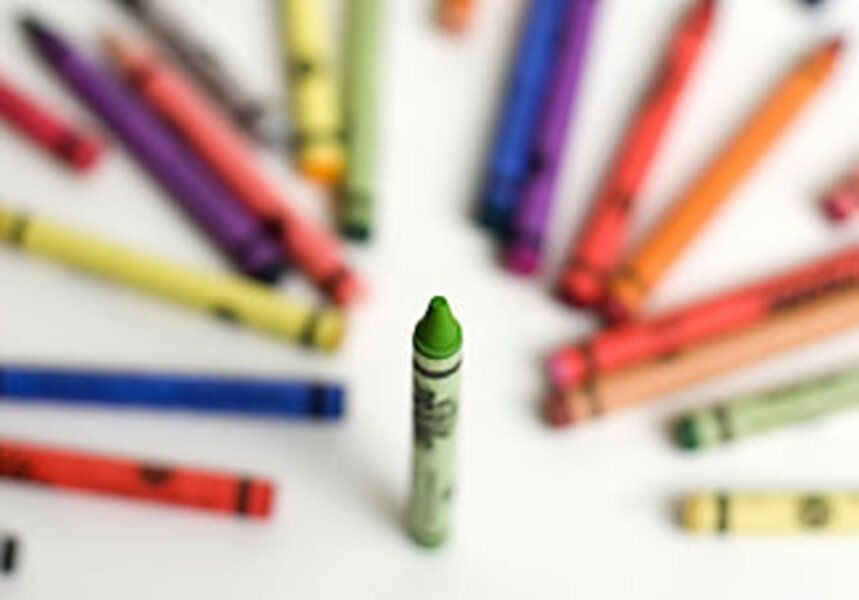For kids: 'Green' crayons!
Loading...
Ever consider coloring a picture with soybeans? Soybeans are a versatile vegetable that can be used to make fuel for vehicles, candles, and even crayons. That's right – crayons!
Crayons have been a staple in schools for more than 100 years, and most of the time they're made from paraffin wax. Paraffin is a byproduct of petroleum, which is used to make gasoline and other goods. And paraffin wax can take decades or even up to a century to decompose, or break down, once it gets to the garbage dump, estimates Bernie Tao, a professor at Purdue University in West Lafayette, Ind.
Making crayons from soy wax has environmental benefits because soy is a renewable resource and decomposes more quickly than paraffin wax.
Crayola, the biggest manufacturer of crayons, makes around 12 million paraffin-wax crayons each day and more than 3 billion crayons each year. Add in all the paraffin crayons produced by other companies, and there are a lot of crayons floating around the globe taking a long time to decompose.
From vegetable to colorful creation
Barbara Lee DaBoll, a teacher and entrepreneur in California, started making her own soy crayons, called Crayon Rocks, a year and a half ago. These crayons are made with soy wax and are shaped like smooth, triangular pebbles.
The crayons were originally designed for special-education students who have trouble gripping regular crayons. But they have since found an avid following among environmentally minded shoppers.
"I've never targeted the environmental groups but they've all found me," Ms. DaBoll says.
Soy crayons tend to be brighter on paper than standard crayons, Ms. DaBoll says. "You get a lot of beautiful texture. It looks like an oil pastel; they're so creamy."
Dr. Tao worked with three students at Purdue University in 1993 to create the first biodegradable crayons made from soy.
The students thought soybean oil would be a good alternative to paraffin wax because it is rich in oils that can be converted into hard wax. Using a chemical reaction process, the students found that indeed they could make the soy oil harden.
Dixon Ticonderoga, a company that makes pencils and art supplies, purchased the rights to produce a line of soybean crayons from the students. Over the past decade, the company has been experimenting with the amount of soy its crayons contain. Today the soy content is somewhere between 15 percent and 25 percent, says Rachael Gaines, senior marketing manager for Dixon Ticonderoga.
"If there's too high a soy content, the crayons are more apt to break," she explains.
Customers like the fact that the soy crayons are ecofriendly, Ms. Gaines says, "especially in this time of 'green' consciousness."
About those soybeans
Soybeans are plentiful – the United States is the largest producer of soybeans in the world. The beans grow in small pods that hang from plants. If the soybeans are removed and squeezed, they release soy oil that can be turned into wax.
Soy crayons are an alternative for anyone shopping for a new box of crayons. But that still leaves billions of old crayon pieces lying around. By the time most kids reach their 10th birthday, they have worn down more than 700 crayons (about seven pounds) – enough to cover an NBA basketball court!
These crayons can be recycled and reused instead of being thrown out, says LuAnn Foty. Ms. Foty started recycling old crayons 15 years ago in her laundry room. Today, working from a single-car garage in Wisconsin, she estimates that she's recycled 36,000 pounds of unwanted crayons. Ms. Forty says she can recycle soy crayons as well.
Schools and government agencies across the country send her more that 4,000 pounds of old crayon pieces each year that she melts down and molds into new crayons in a variety of shapes including butterflies, flowers, dinosaurs, and even a replica of the Statue of Liberty.
"Schools are the main source of crayons [sent to be recycled]," Ms. Forty says. But she acknowledges that her recycling efforts are "just a drop in the bucket [compared with] what's out there."





